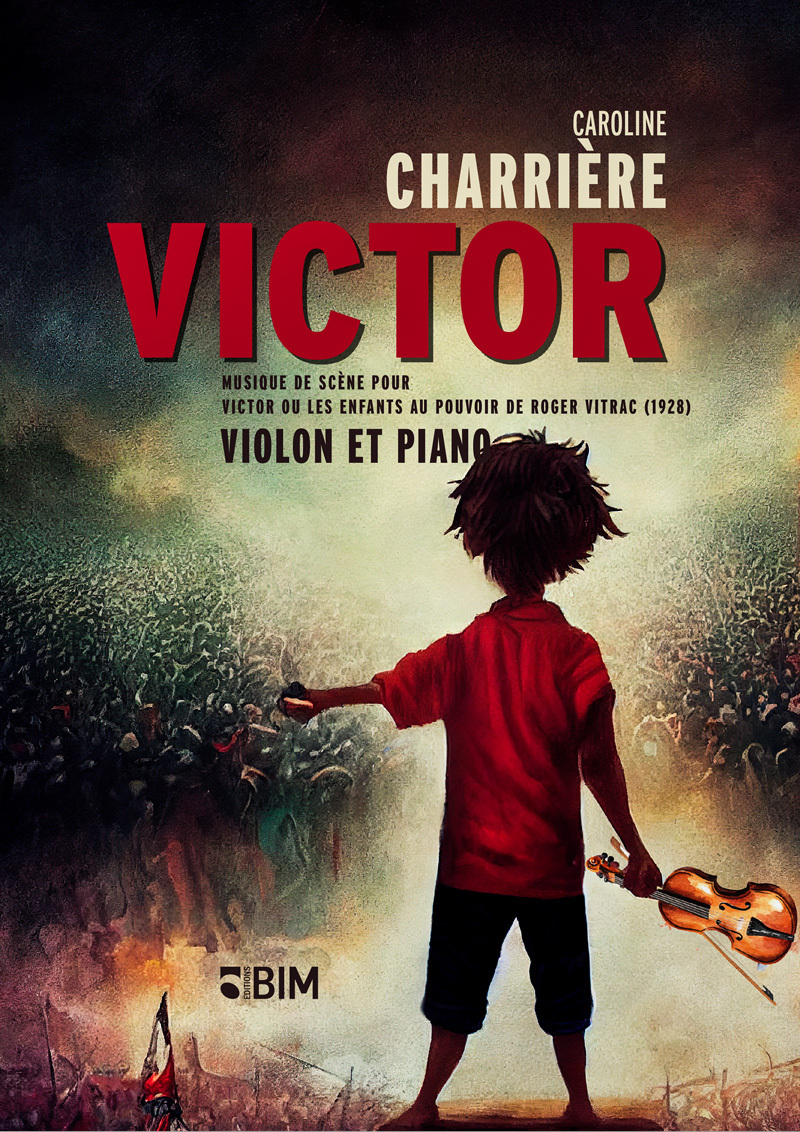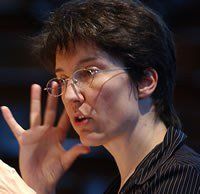


Victor
Musique de scène
for violin and piano
VN39 - CHF29.00 (Print)

Caroline Charrière (1960-2018)
Incidental Music for Victor ou les Enfants au pouvoir by Roger Vitrac (1928)
Between 2001 and 2006, Caroline Charrière wrote several pieces of music for the Théâtre des Osses in Fribourg, either for existing plays or for plays commissioned by the institution, notably from the French-speaking author Isabelle Daccord.
The play Victor ou Les enfants au pouvoir, by Roger Vitrac, was created in Paris in 1928. It is about the grimacing image of French society, but also about its recent history and the world of theater at the time. The surrealist approach reverses the roles of children and parents and the children do not hesitate to point out the hypocrisy of the adult world. No certainty resists their merciless gaze, and the whole of society wavers under their perceptive gaze.
About her incidental music, the composer writes:
"It was a delicate exercise to write the music for Victor. I always try to capture the atmosphere of the play, the character of the characters, their evolution, and here, it seemed to me that I had to contain everything: laughter, tears, madness, dreams, cruelty, I finally opted for a music of salon, such as it was practiced in the bourgeois families, at the end of XIX - beginning of XX century and the duet violin and piano was then very indicated for this kind of music. I have made it sometimes light, sometimes grating, sometimes very sweet, even old-fashioned. A few hammering rhythms also evoke a background of patriotism."
Humor, often caustic, is omnipresent, for example when the horse's gallop turns into a Radetzky march (No. 8). But when the disgust at hypocrisy becomes too unbearable (no. 6, "Des cochons, des cochons"), all that remains of the music is a nervous tapping of the fingers on a small drum. As for death (No. 10), it is represented by long chords on which hover high notes of the violin, a way to illustrate the suspended time, stylistic figure recurring in the music of Caroline Charriere. Equally typical of her writing are the "pulsed ostinati" that illustrate the sequence No. 3, entitled "In a strange dream": an undulating motif in a tight ambitus that evolves rhythmically and melodically in an almost imperceptible way, before being syncopated and fragmented by the violin.
The composer took the message of the piece very seriously, perceiving its realism underneath its absurdity, the quest for truth having been one of the leitmotivs of her life.
Publishing this incidental music as a small suite for violin and piano is a good idea, as the essentially playful music allows the performers to try out the special effects of modern music, such as prepared piano and distorted violin sounds.
Incidental Music for Victor ou les Enfants au pouvoir by Roger Vitrac (1928)
Between 2001 and 2006, Caroline Charrière wrote several pieces of music for the Théâtre des Osses in Fribourg, either for existing plays or for plays commissioned by the institution, notably from the French-speaking author Isabelle Daccord.
The play Victor ou Les enfants au pouvoir, by Roger Vitrac, was created in Paris in 1928. It is about the grimacing image of French society, but also about its recent history and the world of theater at the time. The surrealist approach reverses the roles of children and parents and the children do not hesitate to point out the hypocrisy of the adult world. No certainty resists their merciless gaze, and the whole of society wavers under their perceptive gaze.
About her incidental music, the composer writes:
"It was a delicate exercise to write the music for Victor. I always try to capture the atmosphere of the play, the character of the characters, their evolution, and here, it seemed to me that I had to contain everything: laughter, tears, madness, dreams, cruelty, I finally opted for a music of salon, such as it was practiced in the bourgeois families, at the end of XIX - beginning of XX century and the duet violin and piano was then very indicated for this kind of music. I have made it sometimes light, sometimes grating, sometimes very sweet, even old-fashioned. A few hammering rhythms also evoke a background of patriotism."
Humor, often caustic, is omnipresent, for example when the horse's gallop turns into a Radetzky march (No. 8). But when the disgust at hypocrisy becomes too unbearable (no. 6, "Des cochons, des cochons"), all that remains of the music is a nervous tapping of the fingers on a small drum. As for death (No. 10), it is represented by long chords on which hover high notes of the violin, a way to illustrate the suspended time, stylistic figure recurring in the music of Caroline Charriere. Equally typical of her writing are the "pulsed ostinati" that illustrate the sequence No. 3, entitled "In a strange dream": an undulating motif in a tight ambitus that evolves rhythmically and melodically in an almost imperceptible way, before being syncopated and fragmented by the violin.
The composer took the message of the piece very seriously, perceiving its realism underneath its absurdity, the quest for truth having been one of the leitmotivs of her life.
Publishing this incidental music as a small suite for violin and piano is a good idea, as the essentially playful music allows the performers to try out the special effects of modern music, such as prepared piano and distorted violin sounds.